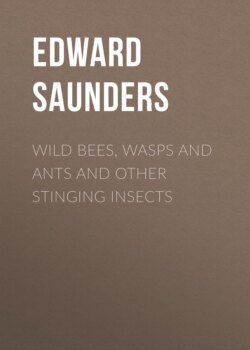Читать книгу Wild Bees, Wasps and Ants and Other Stinging Insects - Edward Saunders - Страница 7
На сайте Литреса книга снята с продажи.
THE SUBJECT IN GENERAL
ОглавлениеTable of Contents
I think I ought here to say why I propose to limit myself to an account of a certain portion only of the Hymenoptera. The reason for this, in the first place, is that the section which I have selected is the only one of which I have any special knowledge; it consists of the bees, wasps, ants and sandwasps, four groups which make up the stinging section of the order—or perhaps more accurately, which have poison bags connected with their egg-laying apparatus or ovipositor. Another reason for their selection lies in their nesting habits; these enable one to get a further insight into their economy and ways than can be obtained from those of almost any other group or order—at any rate they make them comparatively easy to study; one can, so to say, find these little creatures at home, whereas in most orders there seems to be no definite home to which the individuals may be traced; a great advantage also in selecting the stinging groups for study is that they are creatures of the spring and summer, and of the sunshine, so that the weather which tempts them out to their duties is of the kind most agreeable to those who wish to investigate their habits.
The habits of the hive bee have not been touched on, as so many excellent treatises have been written on them that any observations here would be superfluous.
Although these groups are distinguished by their stinging habits, it is only the female that possesses a sting—the male is a most harmless creature and quite incapable of injuring any one. A male wasp or even a male hornet may be handled with absolute impunity, only it is wise to be certain as to the sex of the individual before presuming to play with it too much! A word here may perhaps be said about stinging. People often talk about a gnat stinging or a stinging fly; it may be difficult to define exactly what "to sting" means, but the writer has always considered that a sting is inflicted by the tail end of the creature or a bite by the mouth. A fly or gnat no doubt inserts its proboscis into one's flesh just as a wasp does its sting; but the actions of such opposite parts of the body surely demand distinct names. As we have been alluding to flies it may not be inappropriate to say here that all the creatures we are going to consider have four membranous wings except the worker ants and a very few forms which are comparatively seldom met with. By this character they may at once be known from flies, which have only two membranous wings. The large brown "drone flies", so often seen on the windows of our rooms, especially in autumn, and which most people mistake for hive bees, to which they certainly bear a considerable general resemblance, may be detected at once by wanting the two hind wings of the bee.
The "aculeate", or stinging, Hymenoptera, are divided into sections and families according to their structure; but the groups which stand out most clearly in regard to their habits are the solitary and social species, the predaceous and non-predaceous and the inquilines or cuckoos.
The vast majority of the aculeate Hymenoptera are what are called "solitary", i.e. one male and one female alone are interested in the production of the nest; but there are also three "social" groups—the ants, the true wasps, and the humble and hive bees.
These are called social because they form communities and all work together towards the maintenance of the nest. In the social species there are two forms of the females—the queens and the workers; these latter have the ovaries imperfectly developed, and in the humble bees and wasps they only differ outwardly from the fully developed females or queens by being smaller. In the ants, however, the workers are wingless, and of a very different form from that of the queen. The rôle of these workers seems to be to do the general work of the nest; they have been known to lay fertile eggs, but the resulting offspring has always been male.
Between these conditions of solitary and social we know of no actually intermediate stages. We do not seem to see any attempts on the part of solitary bees to become social or vice versâ. The only condition known which could possibly be considered as intermediate is shown in certain species where a number of individuals make their nests close to each other in some particular bank, forming a colony. These colonies are sometimes very extensive, and the burrows of the individual bees very close together; it has also been shown that the burrows sometimes unite—at the same time there seems to be no positive evidence that there is any work done in the colony which could be considered as done for the common good.
